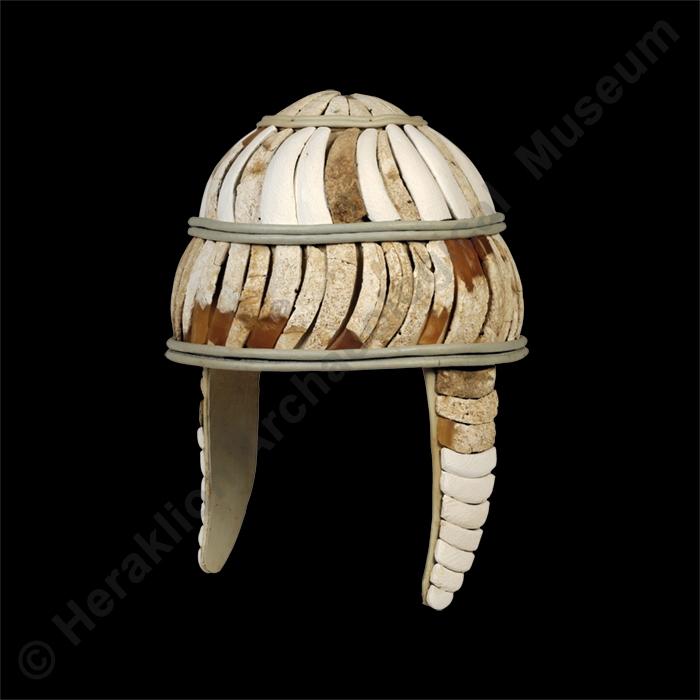Boar's-tusk helmet with cheek guards
Ο-Ε175
Bone (boar's tusk)
Conserved, modern reconstruction of the helmet using the boar's tusks found in the excavation.
Height: 33 cm. Width: 24 cm.
Knossos
Zafer Papoura
Late Bronze Age. Final Palatial period, Late Minoan ΙI period.:
1450-1400 BC:
Gallery:
XCase:
105Exhibition thematic unit:
Late Bronze Age - Neopalatial period (1700-1450 BC) - Final Palatial period (1450-1300 BC).The cemeteriesThe cemeteries of Knossos
Description
Boar’s-tusk helmet made of rows of wild boars’ tusks attached to a leather or cloth base, with cheek guards to protect the warrior’s face. This type of helmet is described in detail in Homer’s Iliad, being worn by the Cretan hero Meriones. This particular example was found accompanying a burial along with weapons and other insignia of rank, in a chamber tomb at Zafer Papoura in Knossos. It has been restored with a modern base and cheek guards, using the 80 intact boars’ tusks discovered during the excavation. Its delicate construction indicates that it was not used as actual armour but as a symbol of rank at ceremonial displays. Such helmets were also produced in mainland Greece, while they are depicted on Late Bronze Age vases, frescoes and other artefacts made of various materials. The deposition of armour and weapons in tombs during the Final Palatial period marks the burials of illustrious warriors of the new Mycenaean aristocracy of Crete, which was associated ideologically, and perhaps also as a population, with mainland Greece. The discovery of remains of similar boar’s-tusk helmets in the Neopalatial cemetery of Poros indicates that the custom was introduced earlier than previously thought. A similar example has been found in the cemetery of Armenoi in Rethymno.Bibliography:
Evans, A.J. The Prehistoric Tombs of Knossos, London, 1906. Dimopoulou-Rethemiotaki, Ν. Το Αρχαιολογικό Μουσείο Ηρακλείου, Athens, 2005, 207. Borchhardt, J. Homerische Helme. Helmformen der ?g?is in ihren Beziehungen zu orientalischen und europ?ischen Helmen in der Bronze- und fr?hen Eisenzeit, Mainz, 1972. Andreadaki-Vlazaki, M. “The Achaean warrior of Kydonia.” In M. Andreadaki-Vlazaki and A. Balaska (eds), The Greeks. Agamemnon to Alexander the Great, Athens, 2014, 130-133. Alberti, L., “The Late Minoan II-IIIA1 Warrior Graves at Knossos: the burial assemblages.” In G. Cadogan, E. Hatzaki, and A. Vasilakis (eds), Knossos: Palace, City, State. BSA Studies 12, London, 2004, 127-136.Author:
G. F.Photographs' metadata
